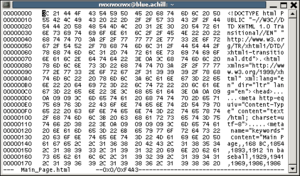Hex editor facts for kids
A hex editor is a special computer program that lets you look at and change the raw, basic information inside a computer file. Think of it like seeing the secret code of a file! The word 'hex' comes from 'hexadecimal', which is a way to show computer data using numbers and letters (0-9 and A-F).
Computers store all information as binary data, which is just a bunch of 0s and 1s. A hex editor shows you this data in a way that's easier for humans to understand, using hexadecimal numbers. Sometimes, these editors are also called binary file editors or byte editors. If they are used to look at parts of a hard disk or floppy disk, they might be called disk editors.
Contents
What a Hex Editor Does
With a hex editor, you can see the exact, raw information inside a file. This is different from how other programs show you a file. For example, an image editor shows you a picture, but a hex editor shows you the raw numbers that make up that picture.
Hex editors can be super helpful for fixing corrupted data. Sometimes, a file gets a little messed up, and a regular program can't open it. A hex editor lets you go in and fix those tiny errors directly. They can also be used to make small changes to programs, like adding a few instructions, without needing to completely rebuild the program.
How Data Looks in a Hex Editor
In most hex editors, the data from a file is shown in two main ways:
- Hexadecimal values: These are numbers and letters (like 00, FF, 1A) grouped together. Each pair of hex values represents one byte of data.
- ASCII characters: Next to the hex values, you'll see what those bytes look like as regular text. If a byte doesn't represent a printable character (like a space or a letter), it's usually shown as a dot (".").
Handling Large Files
Unlike regular text editors, hex editors are great at handling very large files. They don't try to load the entire file into memory all at once. Instead, they only load the part you're looking at, which makes them very efficient.
History of Hex Editors
Since computers were invented, many different ways to store files have been created. Sometimes, people needed to look at the raw numbers inside these files. Early programs, like SUPERZAP for IBM computers, allowed users to edit raw disk data.
Today, hexadecimal numbers are the standard way to show raw computer data. This is because most computers and files use 8-bit bytes. Hexadecimal (and also octal) numbers make it easy to see which individual bits (the 0s and 1s) are turned on or off within a byte. While hexadecimal is common, some newer tools also offer decimal (our everyday numbers) as an option, making it even easier for some users.
Template Systems
Some hex editors have a cool feature called a template system. This system can show the bytes of a binary file in a more organized way, like a form. Imagine you're looking at a game save file. A template could show you specific values like your character's health or score, instead of just a long string of hex numbers.
Templates usually appear in a separate window next to the main hex editor. They let you easily change values like numbers, text, or even colors, without needing to know the exact location (offset) in the file or convert between hexadecimal and decimal yourself.
These templates can be saved and shared with other users. However, most hex editors have their own unique template file formats, so a template made for one editor might not work with another.
Scripting Systems
Advanced hex editors often include scripting systems. These let users create small programs, called scripts, to automate common tasks. For example, a script could automatically make a specific change to many files at once, or help create more complex templates.
The languages used for these scripts can vary. Some are simple, like basic command lists, while others support full programming languages such as Lua or Python.
Plugin Systems
A few special hex editors also have plugin systems. This means you can add extra tools and features to the editor by installing small programs called plugins. These plugins can extend what the editor can do, often adding new ways to view or interact with file data.
See also
 In Spanish: Editor hexadecimal para niños
In Spanish: Editor hexadecimal para niños
- Comparison of hex editors
- Disk editor
- Hex dump
- Hexadecimal
- Octal



